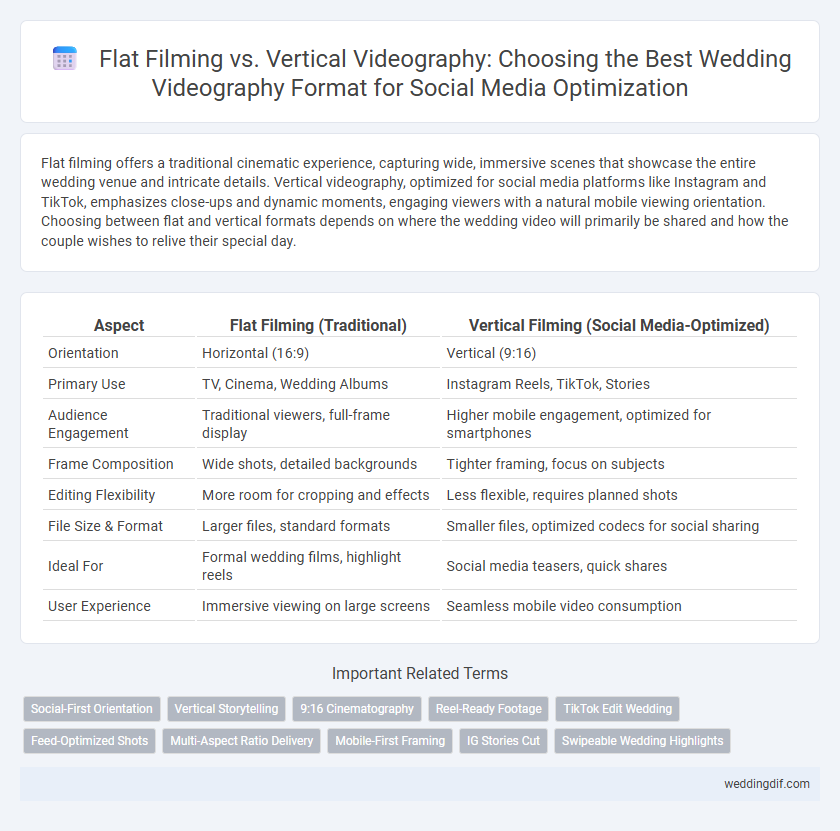Flat filming offers a traditional cinematic experience, capturing wide, immersive scenes that showcase the entire wedding venue and intricate details. Vertical videography, optimized for social media platforms like Instagram and TikTok, emphasizes close-ups and dynamic moments, engaging viewers with a natural mobile viewing orientation. Choosing between flat and vertical formats depends on where the wedding video will primarily be shared and how the couple wishes to relive their special day.
Table of Comparison
| Aspect | Flat Filming (Traditional) | Vertical Filming (Social Media-Optimized) |
|---|---|---|
| Orientation | Horizontal (16:9) | Vertical (9:16) |
| Primary Use | TV, Cinema, Wedding Albums | Instagram Reels, TikTok, Stories |
| Audience Engagement | Traditional viewers, full-frame display | Higher mobile engagement, optimized for smartphones |
| Frame Composition | Wide shots, detailed backgrounds | Tighter framing, focus on subjects |
| Editing Flexibility | More room for cropping and effects | Less flexible, requires planned shots |
| File Size & Format | Larger files, standard formats | Smaller files, optimized codecs for social sharing |
| Ideal For | Formal wedding films, highlight reels | Social media teasers, quick shares |
| User Experience | Immersive viewing on large screens | Seamless mobile video consumption |
Introduction: The Evolution of Wedding Videography
Wedding videography has transformed significantly with the rise of social media platforms prioritizing vertical video formats, affecting how moments are captured and shared. Flat filming traditionally offers a cinematic experience with a widescreen aspect ratio, ideal for classic viewing on large screens. Vertical videography, optimized for platforms like Instagram Reels and TikTok, engages modern audiences by providing immersive, full-screen mobile viewing that enhances social media sharing and storytelling.
Understanding Flat (Horizontal) Filming
Flat (horizontal) filming captures weddings in a traditional 16:9 aspect ratio, providing a wider field of view that showcases the venue, guests, and surroundings comprehensively. This format is optimal for cinematic presentations on large screens and professional editing, preserving visual storytelling with balanced framing. Horizontal videos maintain compatibility with most video players and platforms, ensuring high-quality playback across devices.
The Rise of Vertical Video for Social Media
Vertical videography has surged in popularity for wedding videos due to its seamless compatibility with social media platforms like Instagram, TikTok, and Snapchat, which prioritize vertical formats. This format captures moments in a more immersive and personal way, matching how viewers naturally hold their smartphones, leading to higher engagement rates and shares. While flat filming remains standard for traditional viewing experiences, the rise of vertical video reflects a strategic shift toward maximizing audience reach and visual storytelling on social media channels.
Key Differences Between Flat and Vertical Videography
Flat filming offers a traditional 16:9 aspect ratio that captures the full scene with cinematic depth, ideal for large screens and classic wedding albums. Vertical videography, optimized for social media platforms like Instagram and TikTok, uses a 9:16 aspect ratio to prioritize close-up details and immersive storytelling tailored for mobile viewing. Key differences include framing choices, audience engagement methods, and platform compatibility, making vertical video essential for modern digital sharing while flat video remains preferred for timeless wedding highlights.
Aesthetic Appeal: Cinematic vs. Social-First Styles
Flat filming offers a cinematic, widescreen aesthetic that captures expansive wedding scenes with rich depth and detail, ideal for traditional storytelling. Vertical videography prioritizes social-first styles, emphasizing close-up emotions and dynamic framing tailored for mobile viewing on platforms like Instagram and TikTok. Choosing between these formats affects the visual narrative and viewer engagement, balancing timeless elegance with modern digital trends.
Capturing Emotion: Impact of Video Orientation
Flat filming in wedding videography offers a traditional cinematic experience, capturing wide, detailed scenes that highlight the ambiance and interactions among guests. Vertical videography, optimized for social media platforms like Instagram and TikTok, focuses closely on the couple's emotions and intimate moments, enhancing viewer engagement through a format designed for mobile viewing. Choosing the right video orientation directly impacts how emotions are conveyed and celebrated, influencing the wedding video's resonance with audiences on different platforms.
Social Media Sharing: Native Vertical Formats
Vertical videography, optimized for native social media formats like Instagram Stories and TikTok, enhances user engagement by filling mobile screens and providing an immersive viewing experience. While flat filming (horizontal) captures more expansive scenes, vertical videos maximize social media sharing potential and align seamlessly with platform algorithms. Prioritizing vertical video for wedding highlights facilitates quicker emotional connection and higher shareability among online audiences.
Editing Techniques for Flat and Vertical Videos
Editing techniques for flat filming in wedding videography emphasize widescreen aspect ratios like 16:9, allowing seamless integration of cinematic shots and traditional establishing frames. Vertical videography editing prioritizes dynamic zooms, split screens, and quick cuts optimized for social media platforms, enhancing viewer engagement on smartphones. Color grading and audio mixing strategies adapt to ensure both formats maintain emotional resonance, with vertical edits often featuring tighter framing and more vibrant contrasts tailored for mobile viewing.
Choosing the Right Format for Your Wedding Story
Choosing between flat filming and vertical videography for your wedding story significantly impacts audience engagement and storytelling effectiveness. Flat filming, with its traditional 16:9 aspect ratio, offers cinematic depth and is ideal for larger screens and timeless edits, while vertical videography caters specifically to social media platforms like Instagram and TikTok, maximizing viewer retention through full-screen mobile experience. Understanding your distribution goals and audience preferences ensures your wedding story resonates beautifully across platforms, balancing artistic vision with modern content consumption trends.
Future Trends in Wedding Videography
Flat filming remains popular for traditional wedding videography due to its cinematic quality and widescreen framing, capturing landscapes and large group shots effectively. Vertical videography, optimized for social media platforms like Instagram and TikTok, is rapidly gaining traction by offering immersive, mobile-friendly content that engages younger audiences in real-time. Future trends in wedding videography emphasize hybrid approaches, combining flat and vertical formats using dual cameras and AI-driven editing to cater to both classic viewing and social media sharing.
Flat Filming vs Vertical (Social Media-Optimized) Videography for wedding. Infographic

 weddingdif.com
weddingdif.com